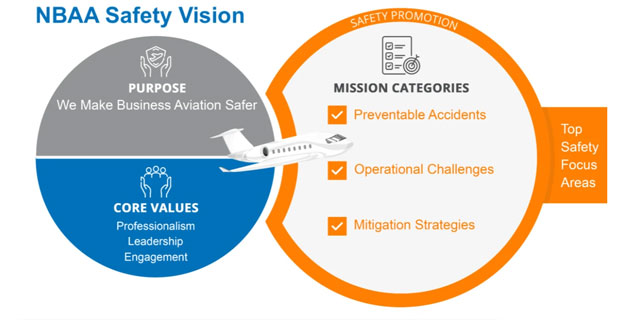In the ever-evolving landscape of aviation, the industry’s commitment to perpetually evolving and enhancing safety standards serves as the foundation upon which the industry’s integrity and reliability are built. At the forefront of this enduring mission is the National Business Aviation Association (NBAA), a trusted source of leadership for business aviation stakeholders worldwide.
As we step into 2024, the NBAA Safety Committee has once again underscored its dedication to safety by gathering over 80 industry experts to take on the challenge of updating and refining their top safety focus areas, a set of priority areas that aim to mitigate risks, enhance operational efficiency, and foster a culture of safety that transcends the confines of the cockpit.

Overview of NBAA 2024 Safety Focus Areas
The NBAA group’s top safety priorities fall into the following three categories, with several areas of focus in each category. Listed here is the NBAA’s highlighted areas of focus for each one:
Preventable Accidents: Highlighting the need to address loss of control in-flight (LOC-I), runway safety, controlled flight into terrain (CFIT), ground operations and maintenance accidents.
*Several of these focus areas have seen accident reductions due to effective mitigation strategies over the last several decades, except for Loss of Control In-flight (LOC-I), which has notably remained the leading cause of total aviation fatalities.
Operational Concerns: Discussing single-pilot operations, human factors, fitness for duty, and workforce challenges.
Mitigation Strategies: Covering safety management system (SMS) implementation, support for safety expenditures, and the use and sharing of safety data.
APS Sidebar: UPRT’s Alignment with NBAA Safety Focus Areas
Upset Prevention and Recovery Training (UPRT), upset training that is beyond the current regulatory requirements typically done in simulators, is emerging as a critical pillar in the underlying architecture of aviation safety. This advanced training not only offers a targeted approach to confronting and mitigating some of the most persistent threats to aircraft operations, but also permeates every aspect of day-to-day flying and profoundly enhances safety culture.

Fostering resilience and competence among pilots, UPRT directly aligns with the NBAA’s objectives to enhance safety across three pivotal dimensions:
-
Addressing Preventable Accidents:
Loss of Control In-flight (LOC-I) Awareness and Preparedness: Notably, in the aviation industry’s ongoing endeavor to enhance safety and reduce the incidence of preventable accidents, significant strides have been made across other focus areas, from runway safety to ground operations. However, one critical area that continues to challenge the industry is Loss of Control In-flight (LOC-I).
LOC-I accidents remain the leading cause of fatalities in aviation, making the need for specialized training like UPRT a critical part of any proactive safety management strategy. UPRT targets LOC-I by equipping pilots with the necessary skills and mental fortitude to effectively prevent, or if necessary, manage and recover from upsets. When properly conducted by UPRT expert instructor pilots, the training ingrains the often counterintuitive skill sets needed to prevent LOC-I while enhancing pilots’ situational awareness, reaction time, and decision-making capabilities under duress, thereby contributing to the reduction of preventable accidents.
-
Supporting Unique Operational Concerns:
Benefits to Single-Pilot Operations: In the realm of single-pilot operations, where the margin for error is slim, UPRT offers a tangible lifeline. The training reduces task saturation—a common precursor to errors—by refining a pilot’s ability to manage high-stress situations with improved handling skills and cognitive resilience. This is particularly crucial in single-pilot operations, where workload and stress levels can escalate rapidly, leaving little room for indecision or error. UPRT’s emphasis on developing a pilot’s capacity to maintain control and make clear-headed decisions under pressure aligns with the NBAA’s focus on addressing the unique challenges faced by single-pilot operations.
-
Enhancing Mitigation Strategies:
Integration with Safety Management Systems (SMS): UPRT’s role extends beyond the cockpit, offering significant benefits to the broader framework of safety management systems. By incorporating UPRT into SMS protocols, organizations can address identified risks with practical, hands-on training solutions that enhance operational safety. This integration inspires a culture of continuous improvement and safety consciousness and keeps awareness keen for every pilot.
In essence, UPRT’s alignment with the NBAA’s 2024 safety focus areas underscores its indispensable role in advancing aviation safety and the need for proactive safety management by incorporating this training, which is mandated at the Part 121 commercial level, into every corporation’s safety management system.




Comments: